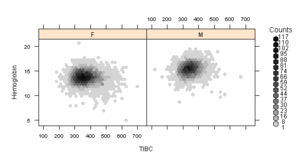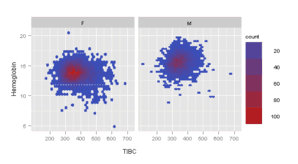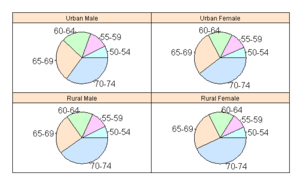ggplot2 Version of Figures in “Lattice: Multivariate Data Visualization with R” (Part 13)
August 20, 2009
This is the 13th post in a series attempting to recreate the figures in Lattice: Multivariate Data Visualization with R (R code available here) with ggplot2.
Previous parts in this series: Part 1, Part 2, Part 3, Part 4, Part 5, Part 6, Part 7, Part 8, Part 9, Part 10, Part 11, Part 12.
Chapter 14 – New Trellis Displays
Topics covered:
- Examples of S3 and S4 methods
- Examples of new high level functions
Figure 14.1
> library(lattice) > library(ggplot2) > library(latticeExtra) |
lattice
> pl <- xyplot(sunspot.year, aspect = "xy", strip = FALSE, + strip.left = TRUE, cut = list(number = 4, overlap = 0.05)) > print(pl) |
ggplot2
> sunspot.g <- function(data, number = 4, overlap = 0.05) {
+ data <- as.data.frame(data)
+ data$id <- if (is.ts(data$x))
+ time(data$x)
+ else seq_along(data$x)
+ intrv <- as.data.frame(co.intervals(data$id, number,
+ overlap))
+ x <- sort(unique(data$id))
+ intervals <- ldply(x, function(x) {
+ t(as.numeric(x < intrv$V2 & x > intrv$V1))
+ })
+ tmp <- melt(cbind(x, intervals), id.var = 1)
+ tmp <- tmp[tmp$value > 0, 1:2]
+ tmp <- rename(tmp, c(x = "id"))
+ merge(data, tmp)
+ }
|
> pg <- ggplot(sunspot.g(sunspot.year), aes(id, x)) + geom_line() +
+ facet_wrap(~variable, scales = "free_x", ncol = 1,
+ as.table = FALSE) + opts(strip.background = theme_blank(),
+ strip.text.x = theme_blank()) + opts(panel.margin = unit(-0.25,
+ "lines")) + xlab("Time")
> print(pg)
|
Figure 14.2
> data(biocAccess, package = "latticeExtra") |
lattice
> ssd <- stl(ts(biocAccess$counts[1:(24 * 30 * 2)], frequency = 24), + "periodic") |
> pl <- xyplot(ssd, xlab = "Time (Days)") > print(pl) |
ggplot2
> time <- data.frame(data = ts(biocAccess$counts[1:(24 * + 30 * 2)], frequency = 24)) > time$id <- as.numeric(time(time$data)) > time$data <- as.numeric(time$data) > time.series <- as.data.frame(ssd$time.series) > time.series <- cbind(time, time.series) > time.series <- melt(time.series, id.vars = "id") |
> pg <- ggplot(time.series, aes(id, value)) + geom_line() +
+ facet_grid(variable ~ ., scales = "free_y") + xlab("Time (Days)")
> print(pg)
|
Figure 14.3
> library("flowViz")
> data(GvHD, package = "flowCore")
|
lattice
> pl <- densityplot(Visit ~ `FSC-H` | Patient, data = GvHD) > print(pl) |
ggplot2
It should be possible to produce a similar graph in ggplot2, however I was not able to figure out how to extract the relevant data from an object of class "flowSet". |
Figure 14.4
> library("hexbin")
> data(NHANES)
|
lattice
> pl <- hexbinplot(Hemoglobin ~ TIBC | Sex, data = NHANES, + aspect = 0.8) > print(pl) |
ggplot2
> pg <- ggplot(NHANES, aes(TIBC, Hemoglobin)) + geom_hex() + + facet_grid(~Sex) + opts(aspect.ratio = 0.8) > print(pg) |
Figure 14.5
> data(Chem97, package = "mlmRev") |
lattice
> panel.piechart <- function(x, y, labels = as.character(y),
+ edges = 200, radius = 0.8, clockwise = FALSE, init.angle = if (clockwise) 90 else 0,
+ density = NULL, angle = 45, col = superpose.polygon$col,
+ border = superpose.polygon$border, lty = superpose.polygon$lty,
+ ...) {
+ stopifnot(require("gridBase"))
+ superpose.polygon <- trellis.par.get("superpose.polygon")
+ opar <- par(no.readonly = TRUE)
+ on.exit(par(opar))
+ if (panel.number() > 1)
+ par(new = TRUE)
+ par(fig = gridFIG(), omi = c(0, 0, 0, 0), mai = c(0,
+ 0, 0, 0))
+ pie(as.numeric(x), labels = labels, edges = edges,
+ radius = radius, clockwise = clockwise, init.angle = init.angle,
+ angle = angle, density = density, col = col,
+ border = border, lty = lty)
+ }
> piechart <- function(x, data = NULL, panel = "panel.piechart",
+ ...) {
+ ocall <- sys.call(sys.parent())
+ ocall[[1]] <- quote(piechart)
+ ccall <- match.call()
+ ccall$data <- data
+ ccall$panel <- panel
+ ccall$default.scales <- list(draw = FALSE)
+ ccall[[1]] <- quote(lattice::barchart)
+ ans <- eval.parent(ccall)
+ ans$call <- ocall
+ ans
+ }
> pl <- piechart(VADeaths, groups = FALSE, xlab = "")
> print(pl)
|
ggplot2
> pg <- ggplot(as.data.frame.table(VADeaths), aes(x = factor(1), + y = Freq, fill = Var1)) + geom_bar(width = 1) + facet_wrap(~Var2, + scales = "free_y") + coord_polar(theta = "y") > print(pg) |
3 Comments
leave one →









Hello
Could you put all the 13 parts in one page or in a pdf, please?
I’d like to print it.
thanks
This has been done already.
Have a look at this.
You can extract and reshape a flowSet into “long” formatted for ggplot2 using the function below:
flowset2ggplot<-function(flowset=NULL){
require(reshape)
require(flowCore)
names<-sampleNames(flowset)
columns<-colnames(flowset)
flowMatrix<-matrix(nrow=0, ncol=length(columns)+1)
for (i in length(flowset)) {
flowMatrix<-rbind(flowMatrix,cbind(name=rep(names[[i]],dim(flowset[[i]])[1]),exprs(flowset[[i]][,columns])))
}
flowFrame<-as.data.frame(flowMatrix)
return(melt(flowFrame,id="name",measure=columns))
}